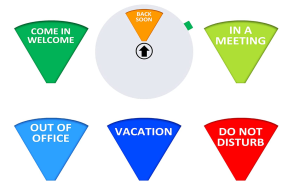Chapter 17: Presentation Skills
Public Speaking and Class Presentations
Public speaking—giving an oral presentation before a class or another group of people—is a special form of interaction common in higher education. You will likely be asked to give a presentation in one of your classes at some point, and your future career may also involve public speaking. It’s important to develop skills for this form of communication.
Public speaking is like participating in class—sharing your thoughts, ideas, and questions with others in the group. In other ways, however, public speaking is very different. You stand in front of the class to speak, rather than from your usual seat—and for most students, that changes the psychology of the situation. You also have time outside of class to prepare your presentation, allowing you to plan it carefully—and, for many, giving more time to worry about it and experience even more anxiety!
Overcoming Anxiety
Glossophobia, or the fear of public speaking, affects many individuals. Although a few people seem to be natural public speakers, most of us feel some stage fright or anxiety about having to speak to a group, at least at first. This is completely normal. We feel like everyone is staring at us and seeing our every flaw, and we’re sure we’ll forget what we want to say or mess up. Take comfort from knowing that almost everyone else is dreading giving class presentations the same as you are! But you can learn to overcome your anxiety and prepare in a way that not only safely gets you through the experience but also leads to success in your presentation. The following are proven strategies for overcoming anxiety when speaking in public:
- Understand anxiety. Since stage fright is normal, don’t try to deny that you’re feeling anxious. A little anxiety can help motivate you to prepare and do your best. Accept this aspect of the process and work to overcome it. Anxiety is usually worst just before you begin and but eases up once you’ve begun.
- Understand that your audience and professor actually want you to succeed. They’re not looking for faults or hoping you’ll fail. Other students and your instructors are on your side, not your enemy. They likely won’t even see your anxiety.
- Reduce anxiety by preparing and practicing. The next section discusses the preparation process in more detail. The more fully you prepare and the more often you have practice, the more your anxiety will go away.
- Focus on what you’re saying, not how you’re saying it. Keep in mind that you have ideas to share, and this is what your classmates and instructors are interested in. Don’t obsess about speaking, but focus on the content of your presentation. Think, for example, of how easily you share your ideas with a friend or family member, as you naturally speak your mind. The same can work with public speaking if you focus on the ideas themselves.
- Develop self-confidence. As you prepare, you will make notes you can refer to during the presentation. You’re not going to forget what you want to say. The more you practice, the more confident you’ll become.
engaging your audience
Strategies to engage your audience include:
- Telling a personal story that relates to your topic
- Comment on a recent event or news
- Show an interesting visual image
- Ask a question (rhetorical or show of hands)
- Tell a funny (but related) anecdote or joke
- Use a unique or interesting prop that is related to the topic
- Get the audience to do something (a poll, an exercise, a game, etc.)
Video source: https://youtu.be/k8GvTgWtR7o
Giving online presentations
In this post-pandemic world, online presentations have become increasingly more popular as a mode of delivery. Online presentations are, themselves, fraught with a different set of challenges. From technological failures, to interruptions and ambient noise (pets, anyone?), or other people walking into the room (let’s hear it for the kiddos!), there are just as many things that can go wrong in a virtual presentation as in a face to face presentation. The first thing you should do before you give any online presentation is turn the camera on and do an environment scan. Can the camera see anything that you don’t want the audience to? You don’t want to make a Zoom blooper reel…
Here are a few more tips that can help:
- Check your tech
- Dress appropriately
- Be animated
- Incorporate tech into the presentation. If you’ve got it, you might as well use it!
- If you’re presenting at home or somewhere where there’s a lot of commotion, consider getting an office door sign like the ones below to let others in your home know that you’re in a meeting. You can even get basic green/red ones that can work well with small children (green = go; red =stop):



Here are some other tips to help you give an A+ Zoom presentation!
Video source: https://youtu.be/1p2miUkU5D8

